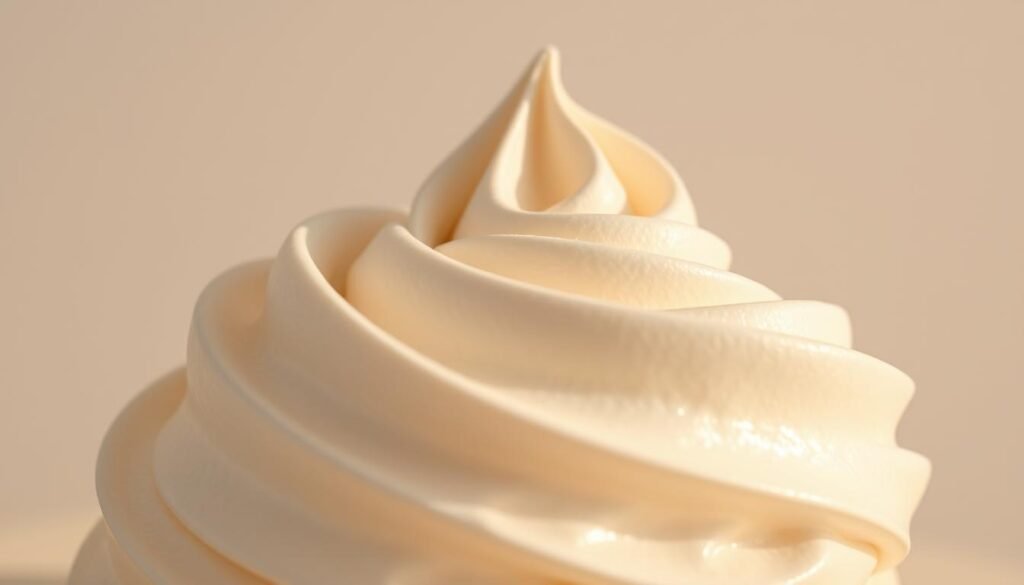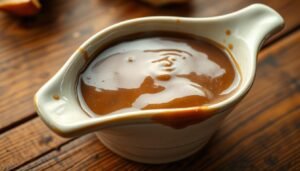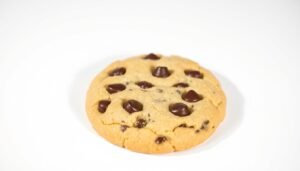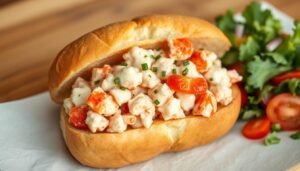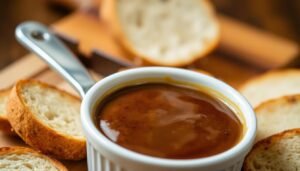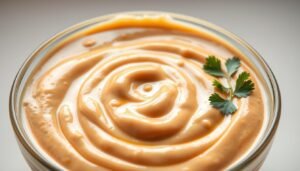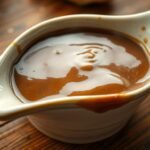Meringue is a classic dessert that’s both light and fluffy. It has been loved for centuries. It’s versatile, from simple meringue cookies to elaborate desserts that are a feast for the eyes.
I still remember my first attempt at making meringue. It was a bit tricky, but the end result was worth it. With a few simple tips and tricks, you can create your own easy meringue treats at home.
Key Takeaways
- Learn how to make a basic meringue recipe
- Discover the secrets to achieving a light and fluffy texture
- Explore different ways to enjoy meringue, from cookies to desserts
- Get tips on how to troubleshoot common meringue-making mistakes
- Find out how to store and serve your meringue creations
What is Meringue?
Meringue is a mix of egg whites and sugar, whipped until it’s perfect. It’s a classic dessert that adds lightness to any sweet treat. This treat has been loved for centuries.
Definition and Characteristics
Meringue has a crisp outside and a soft inside. It’s made by whipping egg whites until stiff, then baking them at a low temperature. Sugar is added to the egg whites, making the meringue stable and tasty.
A well-made meringue doesn’t weep or crack. It shows the meringue was made and baked right. The key is balancing egg whites and sugar, and whipping and baking techniques.
Types of Meringue
There are three main types of meringue: French, Swiss, and Italian. Each has its own special qualities and uses in baking.
- French meringue is the simplest, made by whipping egg whites and adding sugar. It’s great for desserts like pavlova and meringue cookies.
- Swiss meringue heats egg whites and sugar over a double boiler, then whips until stiff. It’s very stable, often used in buttercream frosting.
- Italian meringue slowly adds hot sugar syrup to whipped egg whites, making a smooth meringue. It’s perfect for desserts like lemon meringue pie.
Meringue can be used in many creative ways. For example, in a lobster roll recipe, it adds a light touch to the rich lobster.
| Type of Meringue | Method | Common Uses |
|---|---|---|
| French Meringue | Whipping egg whites, adding sugar | Meringue cookies, pavlova |
| Swiss Meringue | Heating egg whites and sugar over a double boiler | Buttercream frosting |
| Italian Meringue | Pouring hot sugar syrup into whipped egg whites | Lemon meringue pie, whipped cream |
Essential Ingredients for Meringue
Making a great meringue starts with the right ingredients. Each part plays a key role in creating the perfect meringue.
Egg Whites: The Key Element
Egg whites are the heart of meringue, giving it its structure and texture. It’s important to use fresh egg whites for better results. The quality of egg whites affects the meringue’s stability and crispness.
Tip: Use room temperature egg whites for easier whipping and better volume.
Sugar: Types and Importance
Sugar adds sweetness and helps stabilize the egg whites. It also improves the meringue’s texture. You can choose from granulated, superfine, or powdered sugar, each affecting the meringue differently.
| Type of Sugar | Characteristics | Effect on Meringue |
|---|---|---|
| Granulated Sugar | Common sugar used in baking | Can leave a slightly grainy texture if not fully dissolved |
| Superfine Sugar | Finer texture than granulated sugar | Dissolves more easily, resulting in a smoother meringue |
| Powdered Sugar | Very fine, powdery texture | Can make meringue more prone to weeping if not used correctly |
Optional Flavorings and Additions
While egg whites and sugar are essential, you can also add flavorings and ingredients. Vanilla extract, lemon zest, and cocoa powder are popular choices. These can be mixed into the egg whites for even distribution of flavors.
Trying different flavorings can create unique and tasty meringue variations.
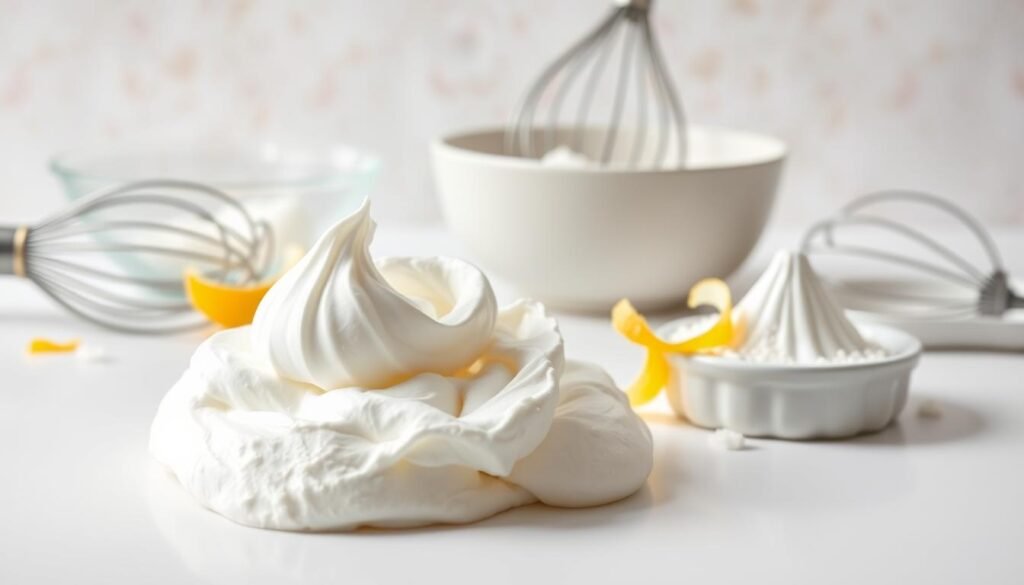
Tools Needed to Make Meringue
Making meringue is more than just mixing ingredients. You need the right tools to get it right. With the right equipment, you’ll make a meringue that tastes great and looks good too.
Mixing Bowls and Utensils
Starting with the right mixing bowls and utensils is key. You’ll need a big, clean bowl for whipping egg whites. Stainless steel or glass bowls work best because they don’t hold fat or oils.
A copper bowl is also good, but it’s pricier. It helps keep egg whites stable.
For mixing, a whisk or spatula is essential. A rubber spatula is best for scraping the bowl and mixing well.
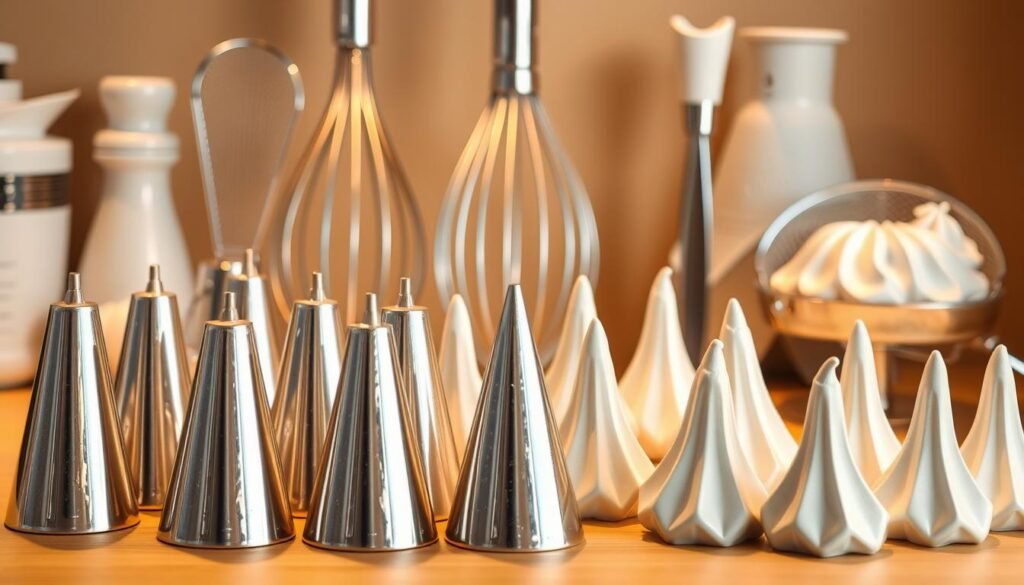
Electric Mixer vs. Hand Whisk
There’s a debate on using an electric mixer or a hand whisk. An electric mixer is faster, whipping egg whites in minutes. But, a hand whisk takes longer, up to 15 minutes.
Both methods make good meringue. It depends on how fast you want it and how much effort you’re willing to put in.
Baking Equipment
After whipping, it’s time to bake. Use a baking sheet with parchment paper to prevent sticking. A silicone mat is also good for easy cleanup.
A regular oven works well for baking. But, a convection oven might bake more evenly. Make sure your oven is at the right temperature and watch your meringue closely.
Step-by-Step Guide to Making Meringue
Making meringue is simple but requires focus to get it right. It’s a key ingredient in many desserts, like meringue cookies and pavlovas.
Preparing the Egg Whites
Start by preparing the egg whites correctly. Make sure the eggs are at room temperature. This helps in creating a stable foam.
Separate the egg whites from the yolks carefully. Any yolk can ruin the whites’ ability to whip.
Use a clean, dry bowl and utensils for egg whites. Even a bit of fat or moisture can stop the whites from whipping.
Whipping Techniques for Perfect Peaks
Whipping the egg whites is key. Start on low speed until they’re frothy. Then, increase the speed and whip until soft peaks form.
Start adding sugar slowly at this point. Keep whipping until you get stiff peaks.
Tips for whipping: An electric mixer makes it easier. Add sugar slowly to avoid a dense mix.
| Whipping Stage | Description | Sugar Addition |
|---|---|---|
| Frothy | Initial stage where egg whites become bubbly | No sugar |
| Soft Peaks | Egg whites form peaks that curl over | Start adding sugar |
| Stiff Peaks | Egg whites form firm peaks that stand upright | Continue adding sugar until fully incorporated |
Baking Time and Temperature
Baking is the last step. The temperature and time are important for perfect meringue. Preheat your oven to 200°F (90°C).
Baking time varies with size and thickness. Meringue cookies take 1.5 to 2 hours. Larger desserts may need longer. Check them often to avoid overcooking.
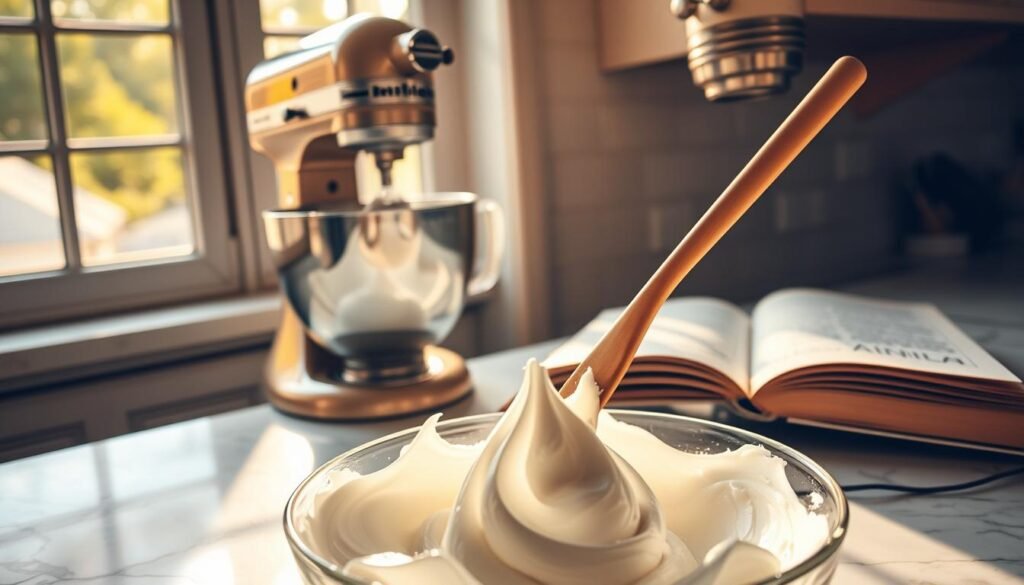
By following these steps and focusing on details, you can make perfect meringue every time. It’s great for meringue cookies or as a pie topping.
Troubleshooting Common Meringue Problems
Making meringue can be tricky, but I’m here to help. Common issues can be frustrating, but don’t worry. I’ve got tips to solve them.
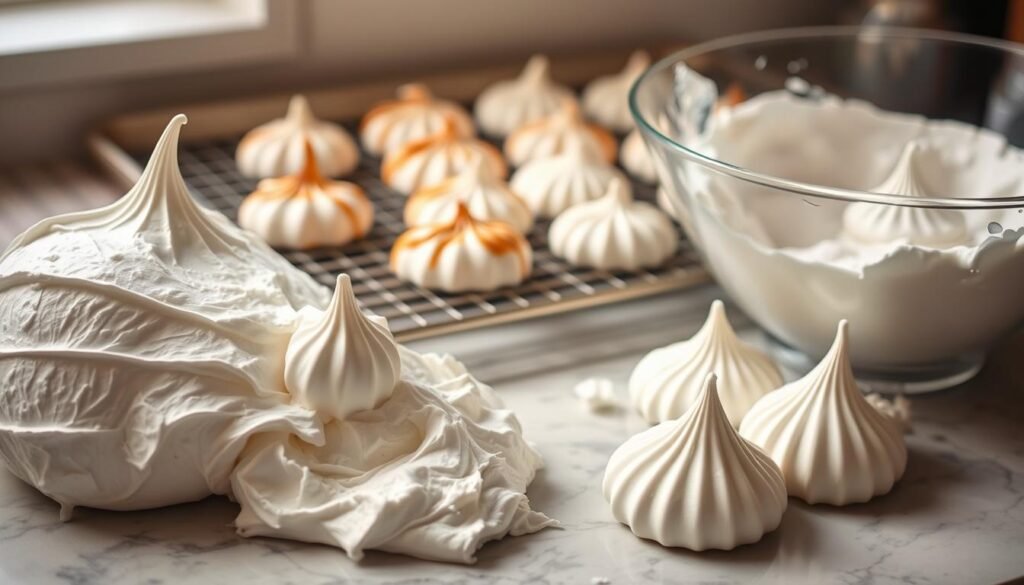
Flat or Weeping Meringue
Flat or weeping meringue is a common problem. It can happen if you underbake or live in a high humidity area. To fix it, bake your meringue at the right temperature and for the right time. If it’s humid, bake when it’s driest.
Cracked Meringue Shells
Cracked meringue shells are a bummer. But, you can prevent them. Overbaking is a big reason, as it dries out the meringue. Bake until it’s lightly golden, and avoid sudden temperature changes.
Over-whipped Egg Whites
Over-whipping egg whites makes meringue too stiff. Stop whipping when they reach the stiff peak stage. Lift some with a spatula; if they hold, they’re ready. Over-whipping makes them hard to work with.
Knowing how to fix these meringue problems will help you succeed. Whether it’s a simple cookie or a complex dessert, these tips will help you achieve beautiful results.
Flavor Variations for Meringue
Try new flavors to make your meringue stand out. Meringue is a great base for many tastes and events.
Classic Vanilla Meringue
Vanilla is a classic choice for meringue. It adds a sweet and creamy taste. Just add a teaspoon of high-quality vanilla extract to your egg whites while whipping.
Chocolate and Coffee Infusions
For a richer taste, try chocolate or coffee in your meringue. Add cocoa powder or melted chocolate for chocolate meringue. Coffee extract gives a mocha flavor.
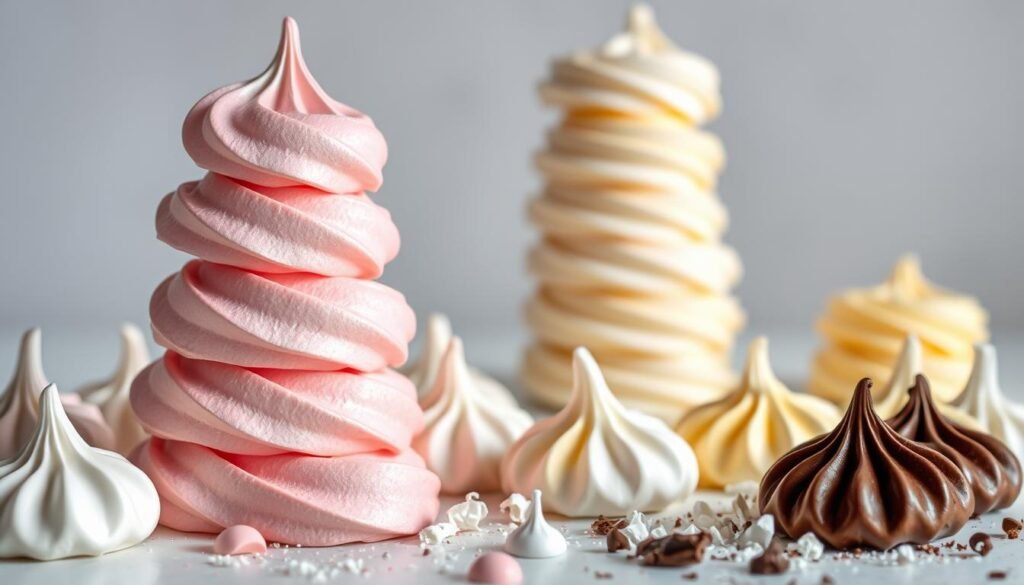
Citrus Zest Additions
Citrus zest, like lemon or orange, brings a fresh taste. Grate the zest over the egg whites and sugar before whipping.
Here’s a comparison of different flavor variations for meringue:
| Flavor | Description | Best Used For |
|---|---|---|
| Vanilla | Sweet and creamy | Classic desserts, pavlovas |
| Chocolate | Rich and decadent | Brownies, chocolate desserts |
| Citrus | Bright and refreshing | Summer desserts, lemon bars |
Try different flavors and ingredients for unique meringue desserts. Whether it’s vanilla or something adventurous, enjoy the process and be creative.
Creative Ways to Use Meringue
I love trying new things with meringue. It’s a versatile dessert that can be used in many ways. From sweet treats to elegant desserts, meringue is perfect.
Meringue Cookies and Kisses
Meringue cookies and kisses are classics. They’re easy to make and always a hit. Just pipe meringue onto a baking sheet and bake until crisp.
You can add vanilla, almond extract, or other flavors to make them even better.
- Pipe meringue mixture into desired shapes
- Bake until crisp and dry
- Flavor with extracts or zests for added taste
Topping for Pies and Tarts
Meringue is great on pies and tarts. It adds a light and airy texture. To make a meringue topping, whip egg whites and sugar until stiff peaks form, then spread over your filling.
Tips for a perfect meringue topping:
- Whip egg whites until stiff peaks form
- Add sugar gradually to stabilize the meringue
- Bake until golden brown
Layered Desserts
Layered desserts are a great way to use meringue. You can make them in many flavors. Just layer meringue with whipped cream, fruit, or other ingredients in a tall glass or bowl.
Some ideas for layered desserts:
- Meringue, whipped cream, and fruit
- Meringue, chocolate sauce, and nuts
- Meringue, caramel, and sea salt
Meringue can make your desserts even more delicious. Whether you’re making cookies, topping pies, or creating layered desserts, meringue adds texture, flavor, and elegance.
Storing and Freezing Meringue
To keep your meringue fresh, it’s important to know how to store and freeze it. The right methods help your meringue stay crisp and delicious.
How to Store Leftover Meringue
Storing leftover meringue right is key to keeping it fresh. Use an airtight container to keep moisture out. You can also use paper bags or wax paper to keep layers from sticking.
Tips for Storing Meringue:
- Keep it away from direct sunlight and heat sources.
- Store in a cool, dry place.
- Avoid storing meringue in humid environments.
Freezing Techniques for Meringue
Freezing is a great way to keep meringue for longer. First, freeze the meringue on a baking sheet lined with parchment paper. Once frozen, move it to an airtight container or freezer bag.
Freezing Tips:
- Label the containers with the date for easy tracking.
- Freeze meringue as soon as possible after baking.
- When you’re ready to use them, simply thaw the meringue at room temperature.
| Storage Method | Duration | Notes |
|---|---|---|
| Airtight Container at Room Temperature | Up to 3 days | Keep away from moisture and heat. |
| Freezer | Up to 2 months | Freeze as soon as possible after baking. |
Vegan Alternatives to Traditional Meringue
Now, vegans can enjoy meringue desserts thanks to new alternatives. Traditional meringue uses egg whites, but plant-based substitutes make it possible for vegans to enjoy these treats.
Aquafaba: The Plant-Based Substitute
Aquafaba, the liquid from canned chickpeas, is a great egg white substitute. It whips up like egg whites, making it perfect for vegan meringue.
Aquafaba is easy to find and use. Just open a can of chickpeas, pour out the liquid, and whip it until frothy.
Recipes Using Aquafaba
Here are a few simple recipes to get you started with aquafaba meringue.
Basic Aquafaba Meringue Recipe
| Ingredient | Quantity |
|---|---|
| Aquafaba | 3 tablespoons |
| Sugar | 1 cup |
| Cream of Tartar | 1/2 teaspoon |
To make the meringue, preheat your oven to 200°F (90°C). Whip the aquafaba and cream of tartar until soft peaks form. Then, add sugar slowly and keep whipping until stiff peaks form.
Spread the meringue on a baking sheet lined with parchment paper. Bake for 1.5 hours. Then, turn off the oven and let it cool completely inside.
Final Tips for Meringue Success
To make a great meringue, pay close attention to timing and temperature. These are key to getting a light and fluffy meringue. Here are some important tips to follow.
Perfect Timing and Temperature
Bake your meringue at the right temperature to avoid it becoming weepy or cracked. Preheat your oven to 200°F (90°C). Then, bake for 1.5 to 2 hours, depending on its size. Watch the time closely to avoid overcooking.
Enhancing Presentation and Serving Suggestions
How you present your meringue is just as important as how it tastes. Top it with fresh fruits or whipped cream for color and flavor. You can also serve it with other desserts, like a lobster roll, for a unique touch.
By using these timing and presentation tips, you’ll be on your way to meringue success. Try different flavors and styles to create your own special meringue dessert.

